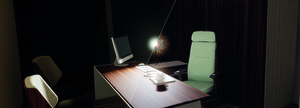Information
- Publication Type: Journal Paper with Conference Talk
- Workgroup(s)/Project(s):
- Date: December 2020
- Journal: IEEE Transactions on Visualization and Computer Graphics
- Volume: Volume 26, Issue 12
- Location: online
- Lecturer: Laura R. Luidolt
- ISSN: 1077-2626
- Event: ISMAR 2020
- DOI: 10.1109/TVCG.2020.3023604
- Call for Papers: Call for Paper
- Conference date: 9. November 2020 – 13. November 2020
- Pages: 3557 – 3567
- Keywords: perception, virtual reality, user studies
Abstract
The perception of light is inherently different inside a virtual reality (VR) or augmented reality (AR) simulation when compared to the real world. Conventional head-worn displays (HWDs) are not able to display the same high dynamic range of brightness and color as the human eye can perceive in the real world. To mimic the perception of real-world scenes in virtual scenes, it is crucial to reproduce the effects of incident light on the human visual system. In order to advance virtual simulations towards perceptual realism, we present an eye-tracked VR/AR simulation comprising effects for gaze-dependent temporal eye adaption, perceptual glare, visual acuity reduction, and scotopic color vision. Our simulation is based on medical expert knowledge and medical studies of the healthy human eye. We conducted the first user study comparing the perception of light in a real-world low-light scene to a VR simulation. Our results show that the proposed combination of simulated visual effects is well received by users and also indicate that an individual adaptation is necessary, because perception of light is highly subjective.Additional Files and Images
Weblinks
- Conference Talk
- Entry in reposiTUm (TU Wien Publication Database)
- Entry in the publication database of TU-Wien
- DOI: 10.1109/TVCG.2020.3023604
BibTeX
@article{luidolt-2020-lightperceptionVR,
title = "Gaze-Dependent Simulation of Light Perception in Virtual
Reality",
author = "Laura R. Luidolt and Michael Wimmer and Katharina Kr\"{o}sl",
year = "2020",
abstract = "The perception of light is inherently different inside a
virtual reality (VR) or augmented reality (AR) simulation
when compared to the real world. Conventional head-worn
displays (HWDs) are not able to display the same high
dynamic range of brightness and color as the human eye can
perceive in the real world. To mimic the perception of
real-world scenes in virtual scenes, it is crucial to
reproduce the effects of incident light on the human visual
system. In order to advance virtual simulations towards
perceptual realism, we present an eye-tracked VR/AR
simulation comprising effects for gaze-dependent temporal
eye adaption, perceptual glare, visual acuity reduction, and
scotopic color vision. Our simulation is based on medical
expert knowledge and medical studies of the healthy human
eye. We conducted the first user study comparing the
perception of light in a real-world low-light scene to a VR
simulation. Our results show that the proposed combination
of simulated visual effects is well received by users and
also indicate that an individual adaptation is necessary,
because perception of light is highly subjective.",
month = dec,
journal = "IEEE Transactions on Visualization and Computer Graphics",
volume = "Volume 26, Issue 12",
issn = "1077-2626",
doi = "10.1109/TVCG.2020.3023604",
pages = "3557--3567",
keywords = "perception, virtual reality, user studies",
URL = "https://www.cg.tuwien.ac.at/research/publications/2020/luidolt-2020-lightperceptionVR/",
}


 paper
paper



